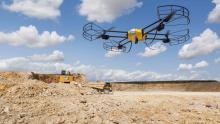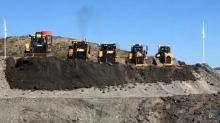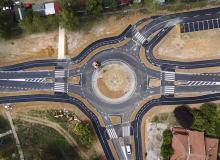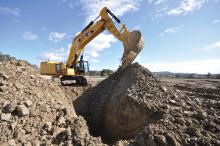Caterpillar may be on its financial back foot, but a recent event showed the company has a vision far beyond this or the next financial year – David Arminas reports. Many construction machinery manufacturers have some data collection and analysis systems for their heavy equipment. For a good decade, manufacturers have been moving in this direction, first as retrofit packages on machines in the field and increasingly as standard on newer models. Caterpillar is no exception among manufacturers that are movin
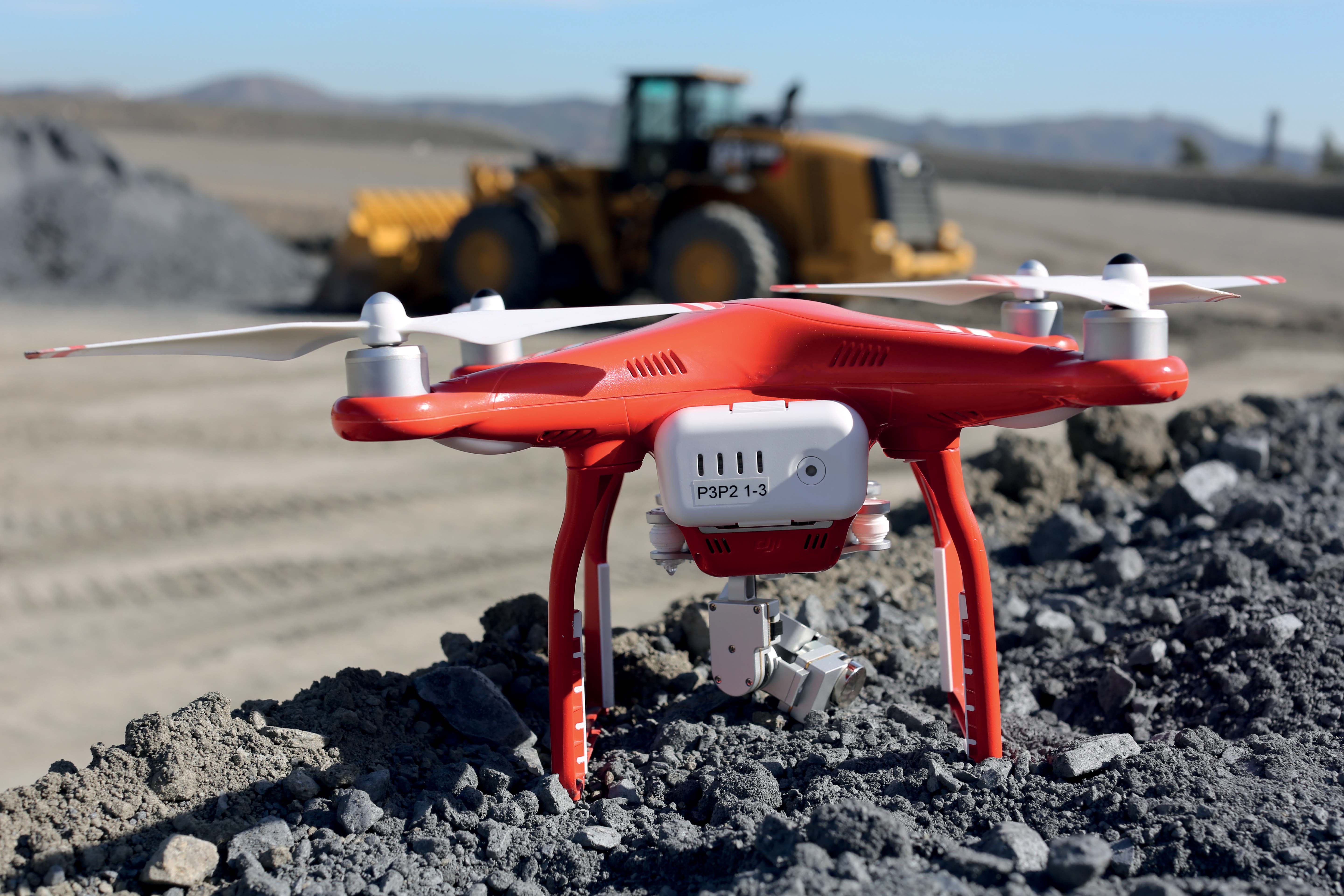
Caterpillar's new technology approach will help boost efficiency
Caterpillar may be on its financial back foot, but a recent event showed the company has a vision far beyond this or the next financial year – David Arminas reports.
Many construction machinery manufacturers have some data collection and analysis systems for their heavy equipment. For a good decade, manufacturers have been moving in this direction, first as retrofit packages on machines in the field and increasingly as standard on newer models.
178 Caterpillar is no exception among manufacturers that are moving in this direction.
However, there were some raised eyebrows at a recent gathering of media and selected Caterpillar dealers from around Europe at the manufacturer’s Malaga demonstration and training centre. The global construction market’s biggest event – bauma – is just around the corner, in Munich in April. Many of the world’s largest and smartest manufacturers, as well as the best known and up-and-coming heavy equipment companies, will be launching new machinery at the event. All, except for Caterpillar, which readily acknowledged to its audience in Malaga in early February that it has no really new equipment for bauma.
Is this heresy for a company known for producing some of the best machinery? Or is it a bold and canny strategic move, and at time of global economic uncertainty?
Caterpillar had gathered people around in February to quietly announce what amounts to a major shift of emphasis towards selling “productivity” to its clients and potential customers. But productivity based not necessarily on operating the newest machinery. Rather, productivity based on making sure clients have access to sufficient data about their machinery as well as their site operations to make profitable decisions.
It’s a risky strategy for a company that until recently has grown globally by doing what it does best - bashing out some of the sector’s finest equipment. Risky because the move comes as the US-based company has had to pull in its financial horns in the past year, something that Caterpillar senior executives saw coming.
Caterpillar recently announced it is looking to close 20 plants worldwide.
Caterpillar is not alone in the construction sector when it comes to feeling a financial squeeze. In November Canada's1413 Finning International, the world's largest dealer of Caterpillar equipment, announced it would cut another 1,100 jobs in Canada and South America and close 11 Canadian locations because of poor sales.
In truth, Caterpillar has been moving toward connectivity for some time. The focus is technologies that control machine performance to give contractors a clear view of how to operate machinery more efficiently. It was a year ago, during the previous annual Caterpillar event in Malaga that Paolo Fellin, vice president of Caterpillar Construction & Infrastructure Industries, said as much.
However, Fellin’s message, reported in a major nterview with World Highways at the time, may have been lost amid launch announcements of a clutch of new machines, many based around cleaner burning engines. Not so this February.
Selling the idea of productivity to customers and potential customers may be a hard sell at this coming bauma. The shift toward more software development for connecting up the worksite has also been no less a hard sell within the company itself, according to Kristian Stoeckel, global marketing manager for Paving Products. Money earmarked for hardware development is migrating towards development of products to boost Caterpillar’s connectivity offering.
Stoeckel commented that in some cities the air coming out the back of a Caterpillar is cleaner than that going into it. An exaggeration it may be, but the point is simple: How much tweaking of engines and machines can politicians demand and engineers manage to make them environmentally acceptable?
These improvements may provide only an incremental boost to productivity unless the operators and contractors can see how best to use these assets. Stoeckel’s argument is that it's not so much what you have, but how you use it. That was Caterpillar’s message in Malaga.
That is not to say Caterpillar is likely to forsake equipment manufacturing, said Stephan Baumler, director of Munich-based1255 Zeppelin Baumaschinen, a major German Caterpillar dealer. Caterpillar must still ensure its products are among the best in the world to keep the customer’s attention in the first place. It is early days, he says, but the global industry is shifting toward data collection and analysis to give manufacturer’s a competitive edge. It is unstoppable.
So what is Caterpillar offering exactly?
At the moment, Caterpillar, like some other companies, has been improving its technology to make it easier for less experienced operators to become productive as soon as possible. Since December, on D6N dozers, there is the Grade Control Slope Assist that can operate to within 1% accuracy of a defined angle. In tests, Caterpillar says the machine can get the job done 58% faster than without the technology, thanks in part to blade adjustments of up 100 per second. While it was introduced last year on smaller models, such as the D3K2, D4K2 and D5K, it will be standard on the D6K and D6T later this year.
Cat Grade with Assist for the medium-size excavator 323F will be available in Europe as a factory fit by mid-year. Joysticks enable the operator to create simple 2D designs in the cab, press the auto button and get to work. Guidance features are built into the base system without the need for data transfer infrastructure. For example, there are grade indicators and audible alerts.
Customers who work with complex grade plans can add Cat AccuGrade for additional 3D capability. Accugrade basically allows compactor operators to view on an in-cab screen the areas that have not reached the required stiffness. Meanwhile, for front-end loaders, there is the Cat Production Measurement package. Operators see on-screen data such as bucket volumes and weight as well as truck-load cycles. Daily production totals are obtainable through Cat VisionLink, produced for Cat by2122 Trimble.
But the marketing deal with Red Bird, announced in December, for Europe, Africa and the Middle East, puts Caterpillar into a different league. Redbird, established in France 2013, analyses aerial data collected by unmanned aerial vhicles (UAVs - better known as drones) - using cloud-based, proprietary algorithms. Caterpillar said at the time that developing relationships with a variety of companies like Redbird would “accelerate our ability to help our customers become more productive."
In 2014, Redbird partnered with2154 Bergerat Monnoyeur, Caterpillar’s exclusive dealer in France and several other countries, including Belgium and Poland. The objective was to develop specific data analytics for Bergerat’s customers. But Redbird is not a drone maker, nor usually a drone operator. It provides a service only through its advanced cloud platform called Cardinal, named after a common small North American bird. No specific software is required, only internet access and a login.
In pilot programmes, Cardinal has analysed on-site data and fed the visual and readable information back to the site operator and manager, until now mostly in quarries.
The Holy Grail is to integrate machine equipment information with 3D site information, Emmanuel de Maistre, co-founder and chief executive of Red Bird, told World Highways during a demonstration in Malaga. De Maistre calls it “Google Map for quarries or construction sites”.
A Phantom quad copter was used to plot an area of the demonstration site. Typically, each ‘picture’ taken overlaps with the next picture by about 80%, allowing for accurate and detailed ground data. Within half an hour there was available a 3D computer graphic of the site.
Redbird’s demonstration drone weighed 1.2kg. Maximum endurance is around 23 minutes and it usually flies between 50-150m high to collect data using GPS coordinates. The maximum area covered in one flight is around 20 hectares per flight but more powerful drones, such as fixed-wing aircraft, can cover up to 100 hectares. A drone can have automatic take-off and landing capabilities and it follows a pre-programmed flight patch. Flight planning can be handled in Cardinal or in the field using just a tablet such as an iPad mini and a mobile app.
One of the most widely used features is the volume measurement tool to monitor stockpiles or volumes of dirt moved. By clicking over it, a customer can have the information about volumes in real time. An even more advanced feature is also available to calculate the difference of volume between two dates. Customers in quarries and construction sites want to know how much volume has been extracted. Now it’s feasible with a few clicks with Cardinal.
“We foresee a close future where drone data combined to machine data will be used to evaluate and optimise the cost per ton, on every part of the site,” he said.
If several fly-pasts are done during the day, the job progression is laid out from one 3D visualisation to the next. Site managers can see on screen what has been done and what needs to be done the next day or week.
As de Maistre said, it is early days yet for such data analysis to be readily available commercially except by very few providers, and even demanded by customers. But he is certain the future lies in that direction, at least for operators of larger quarries and construction sites. Already in Canada, drones are flying thousands of hours in isolated northern territory to survey oil and gas pipelines. Otherwise, it takes days for inspection crews to either drive the pipeline routes – if a road exists – or be helicoptered into the bush for week-long walking inspection tours.
Even in crowded Europe, de Maistra estimates that there are 5,000 companies flying drones for one reason of another. There is an increasing need for this data to be analysed easily in understandable form for site contractors to make strategic decisions.
A tough 2015 and a tough 2016 ahead
Caterpillar total sales and revenue fell to US$11.03 billion in Q4 2015, from $14.24 billion a year earlier.
The world’s biggest construction and mining equipment manufacturer posted a quarterly loss of $87 million.
The US giant has been restructuring aggressively to cut costs because of slower growth in markets including China and Brazil and plunging commodity prices that have hurt customer demand.
The Peoria, Illinois-based company said its outlook for 2016 "does not anticipate improvement in world economic growth or commodity prices”.
Caterpillar sees 2016 revenue within a range of $40 billion to $44 billion. The midpoint of that range, $42 billion, is around $3.5 billion below its forecast in October 2015.
The company said in September it would be cutting as many as 10,000 jobs up to 2018.
Restructuring costs last year were higher than expected, at $908 million. The firm anticipates further restructuring costs of about $400 million this year.
Many construction machinery manufacturers have some data collection and analysis systems for their heavy equipment. For a good decade, manufacturers have been moving in this direction, first as retrofit packages on machines in the field and increasingly as standard on newer models.
However, there were some raised eyebrows at a recent gathering of media and selected Caterpillar dealers from around Europe at the manufacturer’s Malaga demonstration and training centre. The global construction market’s biggest event – bauma – is just around the corner, in Munich in April. Many of the world’s largest and smartest manufacturers, as well as the best known and up-and-coming heavy equipment companies, will be launching new machinery at the event. All, except for Caterpillar, which readily acknowledged to its audience in Malaga in early February that it has no really new equipment for bauma.
Is this heresy for a company known for producing some of the best machinery? Or is it a bold and canny strategic move, and at time of global economic uncertainty?
Caterpillar had gathered people around in February to quietly announce what amounts to a major shift of emphasis towards selling “productivity” to its clients and potential customers. But productivity based not necessarily on operating the newest machinery. Rather, productivity based on making sure clients have access to sufficient data about their machinery as well as their site operations to make profitable decisions.
It’s a risky strategy for a company that until recently has grown globally by doing what it does best - bashing out some of the sector’s finest equipment. Risky because the move comes as the US-based company has had to pull in its financial horns in the past year, something that Caterpillar senior executives saw coming.
Caterpillar recently announced it is looking to close 20 plants worldwide.
Caterpillar is not alone in the construction sector when it comes to feeling a financial squeeze. In November Canada's
In truth, Caterpillar has been moving toward connectivity for some time. The focus is technologies that control machine performance to give contractors a clear view of how to operate machinery more efficiently. It was a year ago, during the previous annual Caterpillar event in Malaga that Paolo Fellin, vice president of Caterpillar Construction & Infrastructure Industries, said as much.
However, Fellin’s message, reported in a major nterview with World Highways at the time, may have been lost amid launch announcements of a clutch of new machines, many based around cleaner burning engines. Not so this February.
Selling the idea of productivity to customers and potential customers may be a hard sell at this coming bauma. The shift toward more software development for connecting up the worksite has also been no less a hard sell within the company itself, according to Kristian Stoeckel, global marketing manager for Paving Products. Money earmarked for hardware development is migrating towards development of products to boost Caterpillar’s connectivity offering.
Stoeckel commented that in some cities the air coming out the back of a Caterpillar is cleaner than that going into it. An exaggeration it may be, but the point is simple: How much tweaking of engines and machines can politicians demand and engineers manage to make them environmentally acceptable?
These improvements may provide only an incremental boost to productivity unless the operators and contractors can see how best to use these assets. Stoeckel’s argument is that it's not so much what you have, but how you use it. That was Caterpillar’s message in Malaga.
That is not to say Caterpillar is likely to forsake equipment manufacturing, said Stephan Baumler, director of Munich-based
So what is Caterpillar offering exactly?
At the moment, Caterpillar, like some other companies, has been improving its technology to make it easier for less experienced operators to become productive as soon as possible. Since December, on D6N dozers, there is the Grade Control Slope Assist that can operate to within 1% accuracy of a defined angle. In tests, Caterpillar says the machine can get the job done 58% faster than without the technology, thanks in part to blade adjustments of up 100 per second. While it was introduced last year on smaller models, such as the D3K2, D4K2 and D5K, it will be standard on the D6K and D6T later this year.
Cat Grade with Assist for the medium-size excavator 323F will be available in Europe as a factory fit by mid-year. Joysticks enable the operator to create simple 2D designs in the cab, press the auto button and get to work. Guidance features are built into the base system without the need for data transfer infrastructure. For example, there are grade indicators and audible alerts.
Customers who work with complex grade plans can add Cat AccuGrade for additional 3D capability. Accugrade basically allows compactor operators to view on an in-cab screen the areas that have not reached the required stiffness. Meanwhile, for front-end loaders, there is the Cat Production Measurement package. Operators see on-screen data such as bucket volumes and weight as well as truck-load cycles. Daily production totals are obtainable through Cat VisionLink, produced for Cat by
But the marketing deal with Red Bird, announced in December, for Europe, Africa and the Middle East, puts Caterpillar into a different league. Redbird, established in France 2013, analyses aerial data collected by unmanned aerial vhicles (UAVs - better known as drones) - using cloud-based, proprietary algorithms. Caterpillar said at the time that developing relationships with a variety of companies like Redbird would “accelerate our ability to help our customers become more productive."
In 2014, Redbird partnered with
In pilot programmes, Cardinal has analysed on-site data and fed the visual and readable information back to the site operator and manager, until now mostly in quarries.
The Holy Grail is to integrate machine equipment information with 3D site information, Emmanuel de Maistre, co-founder and chief executive of Red Bird, told World Highways during a demonstration in Malaga. De Maistre calls it “Google Map for quarries or construction sites”.
A Phantom quad copter was used to plot an area of the demonstration site. Typically, each ‘picture’ taken overlaps with the next picture by about 80%, allowing for accurate and detailed ground data. Within half an hour there was available a 3D computer graphic of the site.
Redbird’s demonstration drone weighed 1.2kg. Maximum endurance is around 23 minutes and it usually flies between 50-150m high to collect data using GPS coordinates. The maximum area covered in one flight is around 20 hectares per flight but more powerful drones, such as fixed-wing aircraft, can cover up to 100 hectares. A drone can have automatic take-off and landing capabilities and it follows a pre-programmed flight patch. Flight planning can be handled in Cardinal or in the field using just a tablet such as an iPad mini and a mobile app.
One of the most widely used features is the volume measurement tool to monitor stockpiles or volumes of dirt moved. By clicking over it, a customer can have the information about volumes in real time. An even more advanced feature is also available to calculate the difference of volume between two dates. Customers in quarries and construction sites want to know how much volume has been extracted. Now it’s feasible with a few clicks with Cardinal.
“We foresee a close future where drone data combined to machine data will be used to evaluate and optimise the cost per ton, on every part of the site,” he said.
If several fly-pasts are done during the day, the job progression is laid out from one 3D visualisation to the next. Site managers can see on screen what has been done and what needs to be done the next day or week.
As de Maistre said, it is early days yet for such data analysis to be readily available commercially except by very few providers, and even demanded by customers. But he is certain the future lies in that direction, at least for operators of larger quarries and construction sites. Already in Canada, drones are flying thousands of hours in isolated northern territory to survey oil and gas pipelines. Otherwise, it takes days for inspection crews to either drive the pipeline routes – if a road exists – or be helicoptered into the bush for week-long walking inspection tours.
Even in crowded Europe, de Maistra estimates that there are 5,000 companies flying drones for one reason of another. There is an increasing need for this data to be analysed easily in understandable form for site contractors to make strategic decisions.
A tough 2015 and a tough 2016 ahead
Caterpillar total sales and revenue fell to US$11.03 billion in Q4 2015, from $14.24 billion a year earlier.
The world’s biggest construction and mining equipment manufacturer posted a quarterly loss of $87 million.
The US giant has been restructuring aggressively to cut costs because of slower growth in markets including China and Brazil and plunging commodity prices that have hurt customer demand.
The Peoria, Illinois-based company said its outlook for 2016 "does not anticipate improvement in world economic growth or commodity prices”.
Caterpillar sees 2016 revenue within a range of $40 billion to $44 billion. The midpoint of that range, $42 billion, is around $3.5 billion below its forecast in October 2015.
The company said in September it would be cutting as many as 10,000 jobs up to 2018.
Restructuring costs last year were higher than expected, at $908 million. The firm anticipates further restructuring costs of about $400 million this year.

